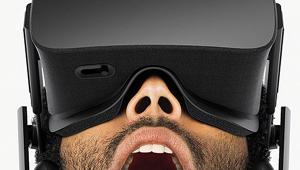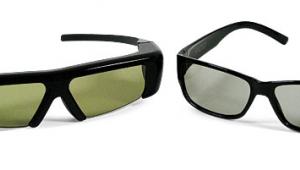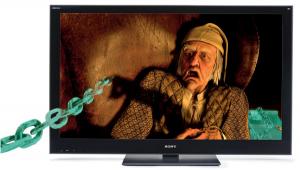Ya I can clearly see the vertical band of light on the edge-lit precision dimming set. The plasma, as usual, has a nice consistent screen. I too didn't particularly enjoy Panasonic's 3D glasses compared to Samsung's when I got to demo both at Best Buy. Looks like you and Tom have been havin some fun on the resent trips you've been taking together! Keep the goods coming!
Panasonic 3D Briefing


For the most part, we didn't learn anything new. Panasonic's VT25 3D plasmas include four screen sizes—50" ($2600), 54" ($3000), 58" ($3400), and 65" ($4300). The two smaller models have been shipping since early May—Tom as the 50-incher in for review now—and the two larger models just started shipping this month. Of course, all models display frame-sequential 3D as well as 2D content, and they all come with one pair of active-shutter glasses; additional pairs are $150 each. And all are THX certified, though that applies only to 2D operation. Panasonic is justifiably proud that the VT25 garnered the Best in Show award at CES 2010—not just the best TV, but the best product, period.
The VT25 embodies several new plasma technologies under the umbrella moniker Infinite Black Pro. These include no pre-discharge, which reduces the amount of light emitted when idling and thus lowers the black level; a new louvre filter that reduces reflections for better contrast in the presence of ambient light; fast-switching phosphors, which improves motion detail; and high-speed drive circuits that also sharpen motion detail and provide smoother gradations than previous generations. All of these improvements enhance 3D operation, but they also improve 2D images as well.
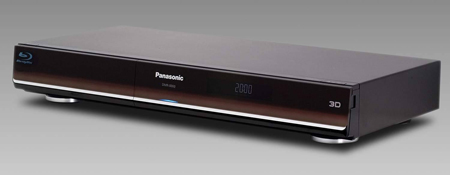
Also on hand was the DMP-BDT300 3D Blu-ray player, which is available now for $429. Other than being able to play 3D Blu-rays, the most obvious—and unique—feature is its twin HDMI outputs, which can be configured to send identical A/V datastreams like an HDMI splitter. More importantly, one can send video to a 3D display while the other sends audio to an older AVR or pre/pro that doesn't offer HDMI 1.4 3D pass-through. This alone is reason enough to choose the BDT300 if you're not ready to upgrade your surround system at the same time.
But wait—there's more! A new, more powerful version of Panasonic's UniPhier chipset substantially improves the video processing in several ways. It also provides an HDMI audio-jitter reducer, and the audio circuits use high-grade components. Finally, it offers most of the online-content and networking features as the TVs.
Panasonic had set up two side-by-side demos—one with a VT25 next to a Samsung C7000 240Hz LED LCD TV and the other with a VT25 beside a Samsung 3D plasma, each pair being fed the same 3D signal from a BDT300. Interestingly, the Panasonic glasses worked with the Samsungs—sometimes—but it certainly wasn't consistent enough to be useful.
Of particular note was the slight crosstalk visible on the LCD—in a paused image from Ice Age: Dawn of the Dinosaurs, a bare twig had faint ghosts on either side, which the Panasonic rep claimed was due to the relatively slow response of the LCD pixels as they switched between the left and right images. No such crosstalk was visible on any of the plasmas, but it was a subtle difference.
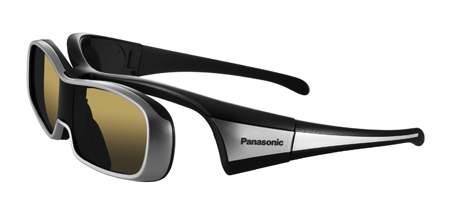
I have to say that I dislike Panasonic's 3D glasses more than any others I've tried so far. They sit directly on the bridge of the nose, which I find uncomfortable, and they let a lot of light in from the sides, making a darkened room even more important.
Next, they switched to hard-disk server feeding 2D clips to all four sets. With horizontally scrolling images, the Panasonic was clearly sharper than the LCD, even though its frame interpolation was enabled, and it was also sharper than the Samsung plasma.
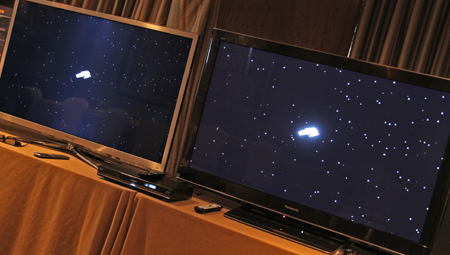
In one clip, a white space ship moved diagonally across a star field. The black of space was nice and deep on both the VT25 and C7000 LCD, but the Samsung's LED edge lighting dimmed the ship along with the surrounding space, which you might be able to see in the photo above. Samsung's so-called "precision dimming" tried to brighten the ship, but this resulted in a vertical band of lighter space above and below it. Also, the plasma displayed many more stars than the LCD during the clip.
Of course, I never completely trust side-by-side demos presented by any company with products from its competitors, but from what I saw, the VT25 plasma performed very well. I look forward to spending some time with the review unit Tom has to see how it does under more controlled conditions.
- Log in or register to post comments

Obviously, it is unfair to make accurate judgments by looking at a picture, but , quite frankly, the only "real" difference I can see between the two sets in the above photograph is an obvious difference in "gamma" settings and color temperature. This can all be adjusted through proper calibration. Because of that, I don't give much credence to such comparisons like this of television monitors "right out of the box" and as stated, given the circumstances, one has to look at it with a "Spockian" raised eyebrow. Unfortunately, "Joe Average" consumer doesn't understand that and will blindly accept this type of demonstration as gospel when making a choice of which set he or she is going to purchase.

The picture confirms exactly what we would expect to see with the very imprecise and bogus "precision" dimming. To be frank, it looks like h#ll. Contrast this to Toshiba coming cell HDTV which have over 500 true local dimming cells. The edgelite Samsung appears to have about 8. It should be obvios that Samsung has taken several steps backwards in performance and is now selling TVs based upon their reputation. Cutting corners to increase profitability. Of course Panasonic has their infamous rising and floating blacks too. About as stupid situation as our educators calling french fries a vegetable. Pick you posion!

It's not so difficult to make an edge-lit LED look awful if you set the backlight to maximum and take a picture from an angle. The question is - would you watch your TV under such conditions? On the other side - have you noticed the strong halo effect surrounding the ship on the plasma screen and the generally lighter blacks? It would be quite interesting to see the comparison made under more fair conditions...

Mar k, we just got a Samsung 3D plasma, so I'm sure we'll be comparing it to the Panasonic, which we still have in the studio. However, I'm not sure when that will be published. William, for the most part, it doesn't seem to matter which 3D player you use with which 3D TV, though we have found some exceptions; for example, the Panasonic player doesn't work with the Titan 3D projector. We now have most of the available players and several TVs, so we're planning a "plugfest" to see what cross-compatibility issues there might be. Stay tuned for that!
